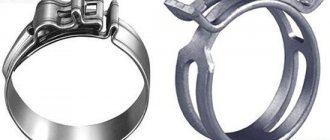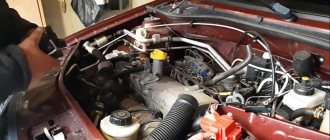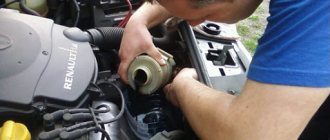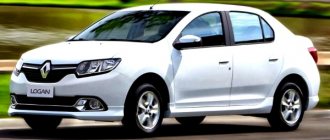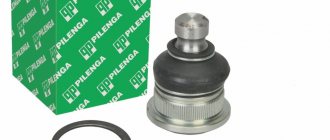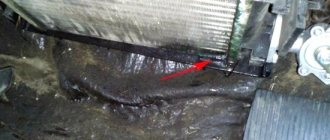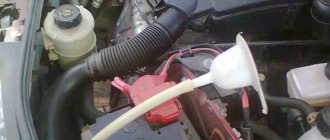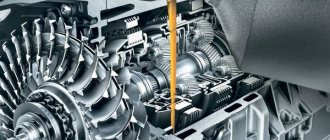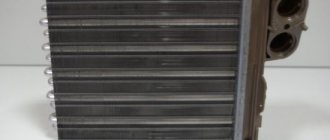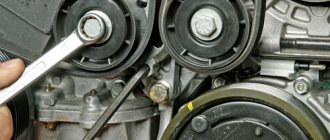For those motorists who have a Renault Logan “iron horse”, it is important to know that the coolant should be replaced every 90 thousand kilometers, or after the car has served faithfully for 6 years. Such parameters and deadlines are set by the manufacturer, and of course, this serves as a guarantee of successful operation of the car.
What kind of antifreeze you need to fill Renault Logan with, how to replace it yourself, and what signs exist for replacing the coolant, you will learn about this and much more from this article.
What and how much to fill in Renault Logan
Engine lubrication system.
Logan is equipped with only three engines: 1.4 liters. 8 valves; 1.6 l. 8 valves; 1.6 l. 16 valves.
If we take the first two engines (1.4 l. 8 valves; 1.6 l. 8 valves), then their volume does not change (3.3 l.) and neither does the oil (ELF EVOLUTION SXR 5W30). But in the case of 1.6 liters. 16 valves, then the oil (ELFEVOLUTION SXR 5W40) and volume (4.9 liters) change.
Engine cooling system.
Here you already need to pour the same antifreeze into all engines: GLACEOL RX Type D, and the volume also does not change - 5.45 liters. Before using antifreeze, it must be diluted with distilled water, the proportion is one to one. In this case, your liquid will solidify only at a temperature of -36 degrees.
Fuel.
The tank has a volume of 50 liters, you need to pour gasoline of at least 92 octane.
Transmission
For manual transmissions, ELF Tranself NFJ 75W80 or Elf Tranself TRJ 75W-80 oil is used, and the fill volume is 3.1 liters.
For the automatic transmission, Elf Renaultmatic D3 SYN Elfmatic G3 oil is used, and 7.6 liters will need to be filled.
The hydraulic booster uses Elf Renaultmatic D3 SYN Elfmatic G3 fluid and needs to be filled with 1 liter.
Brake system.
The brake fluid you need to use is ELF 650 DOT 4, this fluid is well suited for this car and you need to fill it in 0.7 liters, if you fill it with bleeding, it will take one liter.
Preparing to fill coolant
After the antifreeze stops leaking, you need to put new clamps with a worm tightening mechanism on the hoses and put the hoses in their original place, after wiping the connection points from dust and dirt with a cloth.
After this, you can fill in new fresh coolant.
Since 2009, the Renault plant has used Glaceol RX Type D as antifreeze, produced under the ELF brand, which is painted yellow and obtained from a concentrate diluted with distilled water in a 1:1 ratio. It is recommended for use in Renault Logan with 1.4 l or 1.6 l engines.
If your Renault Logan has problems with engine cooling, then the first thing to suspect is the thermostat. Watch the video to see which thermostat company to install for Logan.
Why is it important to change the coolant?
Automotive fluids contain not only mixtures of ethylene glycol and monohydric alcohols, but also anti-corrosion additives. Depending on the type of corrosion inhibitors, coolants are divided into:
- G-11 – based on silicate or nitrite additives.
- G-12, G-12 – based on carboxylic acids.
- G-12 – includes organics and mineral inhibitors.
Mixing all types is not recommended, although the first two are, in principle, allowed. However, it should be taken into account that the service life of the coolant in this case is reduced. Why all these subtleties? The fact is that over time, the properties of chemical additives are lost, and ethylene glycol paired with water begins its corrosive activity. This threatens:
- Possibility of thermostat jamming due to the presence of corrosion products.
- Destruction of the water pump impeller.
- Depressurization of pump bearings.
- Clogged radiator and internal combustion engine channels.
All of the above factors will certainly lead to overheating of the engine, resulting in excessive fuel consumption and a decrease in power. Regular overheating reduces the operational life of the power unit several times.
Such consequences can be avoided by timely replacement of the antifreeze that has expired in full with Renault Logan. In addition, it is important to monitor its condition by periodically looking into the expansion tank.
How should you choose?
In addition to European coolants, you can find products from America and Japan, which may have the same color scheme. Let us immediately make a reservation that the colors of these manufacturers do not mean that their compositions match. You can mix antifreezes of different colors, but of the same composition. This will be indicated on the label of the coolant canister.
The vehicle's operating manual indicates the coolant approval class, which is also on the label. The main criterion for which it is impossible to combine them is the use of additives of different composition. If you accidentally mix two completely different types of coolant, you can get a violent chemical reaction. As a result, a precipitate may form or flakes may form, after which it will become unsuitable for further use.
Choice of antifreeze
Nowadays Renault Logan coolant is presented in huge quantities on the market, so it has become very difficult to make a choice. The article will give some recommendations for selection, and also discuss several popular types of liquids.
- Carboxylate antifreeze. Due to the fact that it has balanced conditions of excellent quality, it can be used at different temperatures. This category of coolant has basic formulas that ensure reliable protection of its properties. This type eliminates the possibility of any unexpected malfunctions occurring during vehicle operation. Therefore, many manufacturers prefer this antifreeze for their cars.
- In the nineties, the hybrid type was in great demand, but today it is also popular among many car owners. This popularity is due to its reliability and long-term preservation of its positive properties.
- The traditional type of coolant is considered outdated, although it has excellent conditioning properties that last for quite a long time
- The most modern and promising development today is the Lobrid type. Due to the fact that the composition includes all kinds of additives and additives that increase the protective properties of the heads and cylinder block, this type occupies a leading position among the favorites in this segment.
Therefore, the Renault Logan cooling system will work perfectly with this type of coolant. But despite this, everyone can choose exactly the one they see fit.
Reviews
Nikolai, 30 years old Good antifreeze, does not freeze even in the most severe cold. It has to be changed every two to three years. Overall I recommend it.
Maxim, 24 years old I have no complaints about this refrigerant, the only negative is the inflated price.
Yuri, 40 years old I always use this original antifreeze as I try to take care of my car and use only original products.
Evgeniy, 53 years old Having studied reviews on the Internet, I still could not understand how this coolant differs from analogues except for the price. Antifreeze may be good, but its cost is not justified.
Filling into the system
To replace antifreeze with Renault Logan, you need to use a funnel. You will have to fill the liquid through the inlet pipe after unscrewing the fitting cap.
There's no need to rush. The liquid must enter the system evenly, which will avoid the formation of air plugs. You should also knead all system hoses by hand from time to time.
Filling is completed after antifreeze flows from the fitting. Here it is important to quickly close the filler hole with your hand to prevent antifreeze from escaping through the outlet valve.
With your free hand, you should quickly replace the fitting plug, and then check the fluid level in the expansion tank. It should be halfway between the minimum and maximum marks.
Currently reading: The engine cooling fan is constantly running. 5 reasons why the radiator fan is always spinning
If necessary, you can add the required amount of liquid.
The work doesn't end there. It is necessary to rid the system of excess air. This procedure goes as follows:
- The reliability of fixation of all covers and clamps is checked.
- The engine starts and warms up in neutral gear to 40 ° C. For precise temperature control, you can use a temperature sensor with a digital display.
- The engine is turned off and the expansion tank cap is unscrewed. You need to be careful with the lid. The pressure in the tank will be excessive.
- After bleeding the air, close the neck of the tank with one hand, and remove the cap from the fitting with the other. After liquid emerges from the drain valve, the caps return to their place.
- To release air from the heater radiator, a pump is connected and the engine is started. The latter should operate at 2,000 rpm for 10 minutes.
- After turning off the engine, you need to bleed excess pressure from the expansion tank again. It is recommended to repeat the procedure several times before full operation.
It is worth remembering that after replacing the antifreeze and carrying out all the necessary manipulations, there will still be air in the system. Its presence will be visible by temperature fluctuations in the system. Therefore, over the course of a month, it will be necessary to bleed off excess air from time to time.
Instructions for filling the system
Using a funnel, new antifreeze is poured into the Logan system through the neck of the expansion tank, while the drain plug must be unscrewed. You should pour slowly, taking pauses, during which you should press all the pipes with your hands to remove air pockets. The process continues until a trickle flows from the fitting; you need to monitor at what exact moment this happens. At the same time, you need to quickly remove the funnel from the neck and close the latter with your right hand, this will stop the liquid from flowing out. Tighten the fitting plug with your left hand, then add the required amount into the expansion tank. Its level should be halfway between the minimum and maximum marks.
The next stage of the replacement operation is the release of air from the cooling system, which is done according to the following algorithm:
- After making sure that all the clamps are tightened and the plugs are tightened, start the engine. Warm it up for several minutes at idle speed to a temperature no higher than 40⁰ (you need to watch at what point this happens), turn off the engine.
- Before bleeding air after replacing the fluid, it is necessary to eliminate excess pressure in the system by unscrewing the expansion tank plug. Attention! The system operates under pressure, so always do this carefully, especially on a hot engine, if you unscrew the cap quickly, hot water will splash out and burn your hands.
- Covering the expansion tank with your right hand, unscrew the fitting with your left hand and remove your hand from the neck of the tank. As soon as the air comes out and liquid runs out of the fitting, close the filler hole again and screw the drain valve plug into place. Screw and tighten the reservoir cap securely.
- Since the Logan heater radiator is located slightly higher than the rest of the engine cooling system, air will still remain in it. To get rid of it, a new one should be pumped in under pressure created by a water pump. To do this, you need to start the engine again and warm it up for 5–10 minutes at high speeds (up to 2000 rpm). At the same time, monitor the temperature sensor to avoid overheating of the power unit.
- Repeat bleeding the air from the fitting, only now do not cover the neck of the tank with your hand, but twist and unscrew its cap to avoid burns to your hands. The procedure will have to be repeated 2-3 times, only then you can drive.
After replacement, there may be residual air in the system for a long time. This may be indicated by temperature fluctuations or insufficient heating in the car interior. Therefore, during the ride, air can be periodically removed, as described in:
If there is a need to flush the Renault Logan cooling system. then you can follow these instructions, only after filling in the flushing fluid it does not make sense to carefully remove the air plugs. It is enough to let the engine run for a while without allowing it to overheat.
Fuel tanks for Renault Logan
| Filling/lubrication point | Refill volume | Name of oil/liquid |
| Fuel tank for all engines | 50 liters | Unleaded gasoline with an octane rating of at least 92 |
| Engine lubrication system (including oil filter) engines: | ||
| 1.4 l. 8 valves | 3.3 liters | ELF EVOLUTION SXR 5W30 |
| 1.6 l. 8 valves | ||
| 1.6 l. 16 valves | 4.9 liters | ELF EVOLUTION SXR 5W40 |
| Engine cooling system: | ||
| For all engines | 5.45 liters | GLACEOL RX Type D |
| Transmission | ||
| Manual transmission | 3.1 liters | ELF Tranself NFJ 75W80 or Elf Tranself TRJ 75W-80 |
| Automatic transmission | 7.6 liters | Elf Renaultmatic D3 SYN Elfmatic G3 |
| Power steering | 1 liter | Elf Renaultmatic D3 SYN Elfmatic G3 |
| Brake system | 0.7 liters (with 1 liter pumping) | ELF 650 DOT 4 |
How to replace coolant on Renault Logan
1. Relieve pressure from the engine cooling system. This is not difficult to do - unscrew the cap of the expansion tank for a few seconds. After equalizing the pressure, return the plug to its place.
2. To provide access to the radiator piping elements, dismantle the air duct of the air purification filter.
3. Renault Logan and other similar cars do not have a standard plug for draining the coolant. This can be done in one way - through the outlet hose, which fits into the lower radiator pipe. Loosen the holding clamp. To do this, insert the blade of a flat screwdriver into the locking connection and turn the tool to disengage the latch. You can disconnect the parts of the lock in another way - pull the latch with pliers or pliers. The clamp will not deteriorate in this case - the standard pipe clamps are disposable, so after dismantling they will still have to be thrown away.
4. Place a bowl or other container under the radiator for used antifreeze. Pulling the hose from the nozzle, we direct a stream of liquid into the vessel.
5. Antifreeze will flow out more intensely if you open the expansion tank cap. This will not allow you to drain all the coolant. To drain the remaining antifreeze liquid that is in the pipes, radiator and engine jackets, we create excess pressure in the cooling system. To do this, compressed air from a car compressor is pumped into the expansion tank, covering the filler neck as tightly as possible with your hand.
6. Some amount of antifreeze somehow remains in the rubber pipes and heater radiator tanks. To drain the coolant from the stove, we depressurize the interior heating system. First, loosen the heater supply hose and remove it from the pipe. To prevent waste coolant from getting onto the gearbox, we direct the hose into a drain container.
7. In a similar way, we disconnect and take down the return line of the heater radiator (an air release fitting is installed on this hose).
8. As in the case of the radiator of the cooling system, all the antifreeze can be expelled from the stove only with the help of a car compressor, which pumps pressure into the heater supply line. Additionally, we supply air to the open pipes - this will remove any remaining coolant.
Video: Replacing coolant on Renault Logan, Sandero, Duster, Largus
And something else useful for you:
9. After the old antifreeze is drained, carefully inspect all hoses. We replace rubber pipes if there are significant abrasions or cracks on their surface, and if the edges have tears.
10. Connect the return and supply hoses of the heater, return the outlet pipe of the radiator of the cooling system to its place. It is recommended to replace the clamps with new ones, even if the removed parts appear intact. If you can’t find standard fasteners, don’t despair - you can use worm-drive clamps from your nearest auto store.
11. Having installed a suitable funnel on the expansion tank (we prepare the device from a 1.5-2 liter plastic bottle), carefully pour in fresh antifreeze.
Since there is air in the cooling system, to bleed it, remove the cap of the bleeder fitting.
12. To speed up the filling of all cavities with coolant, squeeze the radiator connection hoses repeatedly by hand. As the fluid level in the expansion tank decreases, add it in small portions.
13. Antifreeze leaking from the air bleeder nipple indicates that the engine cooling system is full. However, that’s not all – there are still a lot of air pockets in the components and lines of the power unit.
14. To completely remove air, start the engine - the rotating impeller of the pump will drive antifreeze through the remote corners of the engine. However, due to the fact that the units are only partially filled with antifreeze, the deaeration process is carried out in two stages - first in a gentle mode, and after the initial removal of air - at high speeds. Attention: before starting the engine, make sure that the clamps on the pipes are tightened and that plugs are installed on the neck of the expansion tank and the air outlet fitting.
15. Leaving the engine idling, observe the temperature. As soon as the indicator arrow on the dashboard reaches the fourth mark, we turn off the power unit and de-air the circuit. To do this, remove the expansion tank cap and open the drain fitting. After all the air comes out of its hole and antifreeze begins to flow out, tightly cover the filler hole with your palm - the flow will stop immediately. Now you can safely screw the cap onto the fitting.
16. Having screwed on the cap of the expansion tank, start the car and let the engine warm up at higher speeds. The heater radiator of Renault Logan cars is installed quite high, so after depressurization of the system, air will definitely remain in its tanks. To squeeze out existing plugs, the speed is increased to 2000-2500 rpm.
How does our service center replace the coolant on Renault Logan 2?
It is unlikely that the motorist is familiar with some of the nuances of the operation itself, or he will be able to carry out some stages on his own. For example:
- When draining old antifreeze to Logan 2, a problem arises - a small sediment remains in the radiator. Our car service uses its own secrets for complete removal: washing, squeezing clamps, blowing out the tank and thermostat with a compressor. The system will be clean. After emptying, new clamps are usually installed.
- To reduce pressure, remove engine protection, commutations, etc., and also to speed up the process, a special tool is used.
- After pouring in new fluid and topping it up after running through the system, the technicians remove excess air from it so that there are no traffic jams and there are no temperature surges.
DANGEROUS! If a car enthusiast does this on his own, then when removing the blockage of the tank to reduce pressure, he runs the risk of scalding his hands with heated antifreeze.
Risks of using low-quality coolant
Using low quality antifreeze can lead to serious problems. Typical situations include:
- Low-quality fluids can form deposits on the internal surfaces of the engine, water pump, radiator and pipes. This leads to a decrease in heat transfer, due to which the cooling system loses performance and copes with its task worse;
- Uncertified antifreezes often have a short service life. The compositions begin to become cloudy within a few months after filling, even if the system was previously washed and old deposits and contaminants were completely removed from it;
- low-quality liquids can change consistency, becoming a jelly-like mass. It sharply worsens heat transfer, and to completely remove it, you have to perform several complete flushing cycles of the cooling circuit.
How to fill?
The procedure for filling the system with new fluid occurs according to the following scheme:
- Fill coolant through the neck of the expansion tank until antifreeze comes out of the air bleeder hole.
- Screw on the cap of the expansion tank and the fitting cap.
- Start the engine and wait for the cooling system fan to turn on, then stop the engine.
- After the engine has cooled, bleed the air using the fitting and check the coolant level, if necessary, bring it to normal.
- Install engine crankcase protection.
Some car enthusiasts are wondering whether flushing the system is necessary when replacing the coolant on a Renault Logan car, or is it a waste of time? It all depends on the life of the car and the coolant itself.
However, the procedure will not be superfluous in any case. To do this, just insert the hose from the water supply into the filler neck, turn on running water and wait until it comes out clean.
If the radiator does not work satisfactorily, you should wash it yourself or seek help from specialists. If complex contamination is suspected, clean water is poured into the cooling system with the addition of special cleaning agents and the car is operated for 2-3 days. After this, the dirty water is drained and fresh coolant is added.
Recommendations for preparation
The manufacturer recommends changing the coolant every 90 thousand km or after 6 years of operation. It is better to replace the antifreeze earlier, when it acquires a dirty brown tint and begins to emit a sharp, unpleasant odor: at approximately 60 thousand km. To perform the operation, you will need to prepare tools and consumables:
- Standard set of open-end or ring wrenches.
- Pliers.
- Screwdriver.
- Wide container with low sides with a capacity of up to 6 liters for draining waste.
- Funnel, you can use the cut off neck of a plastic bottle.
- Fabric gloves.
- Rags.
It is more convenient to replace antifreeze if there is an inspection ditch. Otherwise, the oil pan protection will have to be unscrewed and removed while lying under the car, and the engine should not be warmed up. Before starting work, remove excess pressure in the cooling system by unscrewing the cap from the neck of the expansion tank. Air will escape from it with a characteristic sound, after which the lid must be screwed back on.
Renault cars do not have special fittings or plugs, and draining is carried out by removing the cooling system pipes, first of all, the lower hose from the radiator. First you need to unscrew and remove the oil pan protection and place the prepared container under the radiator. If work is carried out from a viewing hole, then a board thrown over the ditch can serve as a support for the container.
How to replace antifreeze on Renault Logan?
Replacing antifreeze on a Renault Logan includes draining the fluid, flushing the system if necessary, and adding new antifreeze. Knowing the precautions and what tools should be prepared will help you replace antifreeze on Renault Logan, in particular, as well as on Renault Sandero and Renault Koleos, without difficulty.
A complete replacement of antifreeze on Renault Logan is possible using the following tools and consumables:
- To protect the skin, gloves and thick rags made from natural fabrics are used;
- Tools: ten key for removing crankcase protection;
- screwdriver;
- hose clamps;
- pliers.
- 6 liters of water, which are mixed with ELF GLACEOL RX Type D Renault 7711428132 antifreeze in a ratio of 1/1;
So, how much coolant is needed to replace antifreeze in Renault Sandero and Logan, and which one should you choose? Until 2009, Renault recommended TOTAL GLACELFAUTOSUPRA. Now, this product is practically not found on sale, so a product such as ELF GLACEOL RX TypeD is relevant.
The liquid described above is a concentrate, which is diluted with distilled water in a ratio of 1/1. Owners of Renault Logan with 1.4 and 1.6 engines purchase 5.5 liters of antifreeze. Three 1-liter canisters are diluted halfway with water. The remaining half liter of the finished liquid is used if necessary to add the product to the tank.
Antifreeze for new cars
Many people are interested in what kind of antifreeze is poured into Renault during factory assembly. According to the technical documentation of Renault Logan, this model uses Type D concentrate. This is a special liquid developed according to the proprietary standards of the French automaker. The material is green in color and the crystallization temperature is -40 °C. The liquid contains inorganic inhibitors based on silicate or phosphate. Its average service life is about 3 years.
How to flush the cooling system in a Logan and replace the coolant?
When the car owner has already decided which coolant to fill, you can move on to the next stage. Before replacing, you should give the engine time to cool, and then unscrew the filler plug on the radiator, thereby ensuring that the system is depressurized.
- We install the car on an overpass or pit (you can use a lift).
- Removes the plastic protective panel of the pallet.
- We disconnect the pipe from the lower outlet of the radiator and drain the coolant into a specially selected (according to capacity) container. To ensure that the liquid is drained completely, you should unscrew the plug on the motor block (if it is structurally absent, disconnect the pipes from the thermostat housing).
- When flushing the system, we assemble the circuit together (we connect the previously removed pipes) and fill it with distilled water (it is possible to use a special cleaning additive). We start the Renault Logan engine and load it with various modes for a certain time (depending on the type of “flushing”).
- Using the previously described technology, we disassemble the circuit, drain the flushing liquid, and put it back together (pay attention to the careful tightening of the clamps on the pipes).
- We fill the system with refrigerant, observing the recommended level. We start it up and check the circuit for leaks. Attention! When using concentrate, pay attention to the manufacturer's instructions regarding the proportions for preparing the mixture (with distilled water).
Low-quality antifreeze can cause harm to the elements of the cooling circuit - cause pockets of corrosion and contribute to the acceleration of the formation of deposits. It is better to immediately and permanently decide which antifreeze to fill.
Renault Duster owner reviews all disadvantages
Mini caps for stamped Renault Duster wheels
Front brake pads Renault Duster 1.6
You may also be interested
What antifreeze to fill in Renault Logan
Many people are interested in what kind of antifreeze is poured into Renault during factory assembly. According to the technical documentation of Renault Logan, this model uses Type D concentrate. This is a special liquid developed according to the proprietary standards of the French automaker. Its average service life is about 3 years.
What antifreeze to fill in Lada Vesta
The efficiency of the system depends on the quality and properties of the coolant (coolant) poured in. It is characterized by natural evaporation, so periodically it requires topping up to the level indicated on the expansion tank. If you know what kind of antifreeze is poured into the Lada Vesta at the factory, then you can choose the right technical fluid that will be compatible with the “native” coolant.
What kind of antifreeze is poured into Renault Logan at the factory - we lay out all the nuances
It is not recommended to add antifreeze - it is better to change it
Antifreeze is a coolant that is necessary for the proper operation of the vehicle engine, as well as the entire cooling system. For these reasons, the antifreeze level must be monitored and replaced as necessary.
Neither a driver with many years of experience nor a novice will argue about how important the use of antifreeze is in Russia and the importance of its timely replacement. However, not everyone is familiar with which fluid is best to use on Renault Logan 2 and how to fill it correctly (the procedure for foreign cars of the latest models is somewhat different from domestic cars). In this regard, our car service specialists will tell you more about this.
A common mistake made by many Renault Logan car owners is that they do not know what kind of coolant should be poured into the cooling system. How reliably the car will be operated depends on the correct choice. Therefore, it is important to know the features of choosing antifreeze, as well as which type of refrigerant is better.
Currently reading: Logan gear shift diagram. Changing gears on Renault Logan
- 1 Choice of antifreeze
- 2 Flushing the system and replacing the refrigerant
The Renault Logan car has become very popular in Russia in a short period of time. Car enthusiasts highly appreciated its good maintainability, reliability and low purchase price.
To keep it in working condition, it is enough to undergo periodic maintenance. Changing the coolant is one such item. It’s easy to cope with the task, if you know the nuances, then there shouldn’t be any problems when replacing it yourself.
To maintain longevity in engine operation, it is necessary that all systems work harmoniously and in tact. And regular maintenance of the cooling system is one of these necessary procedures.
The manufacturer regulates the replacement of coolant (coolant) in Renault Logan, Daster, Sandero and Largus cars every 3 years or 90 thousand km - this is indicated in the car’s operating instructions. In practice, antifreeze (in our country drivers call it antifreeze) has to be changed more often - the shelf life is affected by the temperature, the condition of the engine and the quality of the coolant.
Determining that the antifreeze resource is coming to an end is simple - open the cap of the expansion tank and look inside. Visually, the need for replacement is indicated by loss of color, the appearance of an unnatural brown color and sedimentation. You will find out that the freezing temperature of the coolant does not correspond to the norm by measuring the density with a special hydrometer.
Before starting the replacement, we stock up on worm-drive clamps for pipes with a diameter of 20-30 mm and 35-55 mm. We place the car on a flat horizontal platform, allowing the engine to cool if necessary. In order not to drain the toxic liquid onto the ground or garage floor, we take a container for used antifreeze. We carry out further work in accordance with the instructions provided.
Even a novice car enthusiast will not argue about the importance of the cooling system during engine operation. There is also no doubt about the need for a timely change of coolant, since expired refrigerant can cause many troubles.
For those motorists who have a Renault Logan “iron horse”, it is important to know that the coolant should be replaced every 90 thousand kilometers, or after the car has served faithfully for 6 years. Such parameters and deadlines are set by the manufacturer, and of course, this serves as a guarantee of successful operation of the car.
What kind of antifreeze you need to fill Renault Logan with, how to replace it yourself, and what signs exist for replacing the coolant, you will learn about this and much more from this article.
A car, as everyone knows, consumes not only gasoline, but also contains additional filling fluids.
But often car owners go to a service center because they don’t know how and how much to fill antifreeze, hydraulics, motor oil into the engine, etc. And that’s why go to a service center and pay your own money when you can do it all yourself .
If you are the owner of Renault Logan, then you are very lucky that you have come to this page, because we will talk about this particular car.
Renault Glaceol RX Type D is a concentrate and ready-made coolant that is suitable for use in engine cooling systems of modern cars, especially for cars manufactured by the Renault-Nissan concern.
Ready-to-use coolant has a freezing point of -21°C, which, of course, is not suitable for Russian regions, so it is recommended to use concentrated antifreeze diluted with water in a ratio of 50%/50%, which corresponds to a crystallization temperature of up to -37°C.
Neither a driver with many years of experience nor a novice will argue about how important the use of antifreeze is in Russia and the importance of its timely replacement.
However, not everyone is familiar with which fluid is best to use on Renault Logan 2 and how to fill it correctly (the procedure for foreign cars of the latest models is somewhat different from domestic cars).
In this regard, our car service specialists will tell you more about this.
Recommendations
- When changing antifreeze with flushing, you should remember that after draining, about a liter of liquid will remain in the system. If the system was washed with water, then this must be taken into account when diluting the concentrate and subsequent filling with antifreeze.
- If chemical flushing was used, first such flushing is drained, then the system is flushed with water, and only then antifreeze is added.
We also recommend reading the article on how to flush the oil system before changing the engine oil. From this article you will learn about available methods for flushing the engine lubrication system. - To check if there are air pockets in the system, the heater is turned on on a warm car. If the coolant level is normal, but the heater blows cold, you need to remove the air lock.
- After short trips in the first days, you need to monitor the antifreeze level.
The fact is that the level can drop sharply if air pockets remain in the system. It sometimes happens that after replacing antifreeze, the driver may encounter certain malfunctions of the cooling system. For example, leaks may occur. This occurs if sediments have clogged microcracks, but after using chemical washes, such natural “plugs” are washed out.
You may also encounter the fact that after unscrewing and reinstalling the expansion tank cap does not relieve pressure in the system, the valves in the cap do not work. As a result, antifreeze flows through the cap. To avoid such problems, it is better to change the expansion tank cap every 2-3 years or always prepare a new one before replacing antifreeze.
What antifreeze to use for Renault Logan
First, you should clearly understand the following rule: you should only pour coolant into a clean system. This will allow the new antifreeze not to lose all its qualities when mixed with a used product.
The recommendations of the official Renault Logan dealer come down to a type “D” product, ELF brand, called “GLACEOL RX Type D 1L Renault 7711428132”, manufactured by Total. In stores, this product is offered in the form of a concentrated solution in one-liter containers.
Its chemical composition contains the substance ethylene glycol, distilled water and additives consisting of components such as an aqueous solution, glycerin and alcohol. Ethylene glycol and water are the basis of the liquid, which makes up 96 percent of the total volume, the rest is additives.
Before using the concentrate, it must be diluted with distilled water in a ratio of 50X50. And as a container for dilution, you can use plastic bottles of one and a half or two liters. The resistance to winter temperatures of the finished antifreeze inspires confidence; it does not freeze at -35.40 degrees below zero.
Antifreeze from the manufacturer Total is safe for plastic and rubber products, as well as for containers painted with paint or varnish. In order to completely fill Renault Logan with new coolant, it is necessary to prepare 608 liters of working product the day before, its quantity depends on the appetite of the engine.
Antifreeze type GLACEOL RX Type D costs from 330 to 350 rubles per liter, but it is advisable to purchase from trusted sellers or official dealers so as not to “run into” a fake. Distilled water is also sold in specialized auto stores and can be purchased without any problems.
Advantages and disadvantages
1 liter of Renault concentrate
The main advantages of Renault antifreeze Type D:
- Full compatibility with Renault and Nissan engines;
- The chemical composition is completely neutral to various metals, rubber and car enamel;
- Maintaining its normal liquid state up to an air temperature of -36.
Flaws:
- The manufacturer does not recommend diluting antifreeze with other refrigerants. In case of an emergency, it can only be diluted with distilled water or filled with the same coolant;
- Relatively high price compared to refrigerants from other manufacturers;
- It is not always possible to buy this coolant in regular auto stores.
When Renault Logan 2 antifreeze becomes unusable - replacement is necessary
When should I replace this car?
The manufacturer recommends changing the antifreeze fluid after every 90 thousand kilometers.
Although the latest brands allow you to increase this period (up to hundreds of thousands), you should trust your eyes more, that is, check. If the color of the antifreeze has changed, there is no need to delay.
This can happen after a couple of years - it all depends on the condition of the fuel system and cooling system and their operating conditions.
The fact that the life of the old liquid has been exhausted is indicated by its color and smell:
- Antifreeze becomes cloudy and darker.
- It will give off a stronger smell.
What does the technician use to replace antifreeze, besides the liquid itself? The tools are listed below:
- pliers;
- screwdriver;
- standard set of keys;
- container for draining old antifreeze;
- protective gloves (you can just use cloth ones, but rubber ones are better);
- funnel for filling.
Also, an experienced master will always have a rag or rags on hand. Maintaining cleanliness and accuracy in this matter is one of the primary tasks.
But the main thing is not so much the presence of the tool itself, but experience. This will eliminate mistakes that lead to dire consequences.
What happens if you use the wrong liquids?
To increase the effect, some car enthusiasts who independently replace antifreeze allow mixing of different types. It is highly not recommended to make a mixture containing organics and carboxylic acids. Example: in our car service center they will never mix G-11 and G-12. At the client's request, a mixture of G11 and G12 can be prepared. Otherwise:
- The service life of the liquid itself is reduced.
- Over time, the risk of corrosion increases, which can lead to dire consequences:
- thermostat failure;
- clogged radiators and engine channels;
- wear of bearings and water pump impeller, etc.
- the engine will overheat, which means it will wear out, lose power and consume more fuel.
Preparing to replace antifreeze: important tips and tricks
For drivers of a car of this brand, it is better to replace the coolant in advance, namely when it becomes characteristically dirty-brown. In this case, the liquid will become unpleasant and smell sharp, and such changes will occur after 60 thousand kilometers.
To prepare for a simple operation to replace antifreeze, you will need several necessary items, including tools and consumables.
It is important to prepare several types of wrenches, among which there should be open-end and cap options. You should have pliers and a screwdriver on hand. To drain the waste liquid, you need to prepare a wide container with low sides, which would correspond to a volume of 6 liters. Many drivers use the neck of a plastic bottle as a funnel. It is necessary to stock up on rags and cloth or rubber gloves.
Undoubtedly, for convenience, you can use an inspection hole, since in the absence of one you will have to climb under the car and perform all the necessary manipulations while lying on the floor or ground. Before starting work, the engine must be completely cooled, and the valve located at the neck of the expansion tank must be unscrewed to reduce excess pressure in the cooling system. After the cover is removed, you will hear a characteristic sound, after which the cover should return to its place.
Unfortunately, Renault does not have any precautionary plugs or other devices for the release of used antifreeze, so it is drained after removing the system pipes. To begin, remove the lower hose from the radiator, unscrew and remove the tray protecting the crater, then place a container prepared in advance under the radiator. It is more convenient to carry out this work in an inspection hole, then you can throw a board over the hole and install a container on it to collect the waste product.
Design features
The main elements of the cooling system of a French car are:
- cooling fan (note that the Logan fan is electrically driven);
- a centrifugal pump with blades, its operation is ensured by a toothed belt drive (timing belt), directly from the crankshaft pulley, providing forced circulation of cooling fluid (usually antifreeze);
- Logan radiator made of aluminum alloy, equipped with an expansion tank, provides cooling of the liquid and removal of excess liquid formed during heating;
- Renault Logan thermostat regulates the supply and temperature of antifreeze;
- power sensor;
- heater radiator (another name for heater radiator), needed to cool the fluid in the heater;
- hoses (radiator outlet and inlet, as well as heater radiator, steam outlet, filler), pipes (cylinder head exhaust) and connectors for connecting all system components.
Currently reading: Renault Logan 2022 - photo and price, characteristics of Renault Logan 3 in a new body
The operating principle is based on the fact that cooled liquid is supplied directly from the radiator to the system, directly to the pump. The pump pumps antifreeze under pressure to the cylinder block and other components of the power unit. The liquid cools the engine and is supplied to the thermostat; if its temperature does not exceed the set one (89°C), then the thermostat is closed.
Then the antifreeze is supplied to the heater, cooled by the heater radiator, transferring heat to the cabin if necessary, again supplied to the pump and the cycle repeats. This is the so-called small circle of circulation. If the temperature of the coolant exceeds the set one (89°C), the thermostat partially opens (the thermostat can open completely when the antifreeze temperature is above 95°C), it enters the radiator, where it is cooled using the air flow that is formed when the car moves and the fan operates with electric drive, and again supplied to the pump, the cycle repeats. This is a large circle of circulation.
Excess liquid formed during heating enters an expansion tank equipped with an inlet and outlet valve, and antifreeze is poured into it.
Another big problem is air in the cooling system. It is released using a fitting during refueling.
On modifications equipped with air conditioning, repair of the cooling system has a number of differences that our technical center technicians take into account when working.
How to bleed air from the cooling system of a Renault Logan car
After adding antifreeze, you need to bleed excess air from the system. To do this you need to do the following:
- Start the engine and let it run at idle speed. Warming up should be done to a temperature of forty degrees. After this you need to turn off the engine
- Next, you need to eliminate excess pressure in the system. You need to open the expansion tank
You should also remove the plug from the fitting. Air will escape, and after some time liquid will begin to flow from the fitting. After this, of course, you should tighten the cap of the expansion tank
- Next, you need to get rid of the air in the radiator. To do this, turn on the engine again and warm it up at high speeds - two thousand revolutions per minute. Warm-up time: five to ten minutes
- Bleed the air from the fitting again. Only this time you shouldn’t cover the expansion tank with a brush. These steps must be repeated two or three times
Malfunctions and methods for eliminating them
The main symptom of a faulty cooling system is engine overheating; in some cases, the engine cannot reach operating temperature (as a rule, in this situation the thermostat needs to be replaced). And another characteristic malfunction is a constant decrease in the level of coolant in the system.
Diagnosis of faults in this case by car mechanics of the Technical Department is carried out visually, and the following is determined:
- the level of antifreeze in the expansion tank (focusing on the MIN and MAX lines), including the color of the coolant and the presence of foreign impurities (doing this yourself, especially with a running, hot engine, is dangerous to health);
- general condition and degree of tension of the pump drive belt (in some cases, the technicians of our technical center replace the pump);
- the absence of particles in the system elements (radiator, fan) that impede the air flow, this is a typical malfunction; in some cases, the radiator may need to be replaced;
- presence of traces of coolant leakage directly in the engine compartment (possible depressurization of the system).
Is the engine overheating or leaking coolant? Contact Technical Services immediately. We have in stock all Logan spare parts necessary for high-quality and prompt repair of the cooling system, which is performed by experienced and qualified craftsmen using modern equipment using special tools.
We work for you seven days a week from 9:00 to 21:00.
We service Renault cars.
How to bleed air from the cooling system of a Renault Logan car
After adding antifreeze, you need to bleed excess air from the system. To do this you need to do the following:
- Start the engine and let it run at idle speed. Warming up should be done to a temperature of forty degrees. After this you need to turn off the engine
- Next, you need to eliminate excess pressure in the system. You need to open the expansion tank
You should also remove the plug from the fitting. Air will escape, and after some time liquid will begin to flow from the fitting. After this, of course, you should tighten the cap of the expansion tank
- Next, you need to get rid of the air in the radiator. To do this, turn on the engine again and warm it up at high speeds - two thousand revolutions per minute. Warm-up time: five to ten minutes
- Bleed the air from the fitting again. Only this time you shouldn’t cover the expansion tank with a brush. These steps must be repeated two or three times
Causes of leaks
Antifreeze leaks are a fairly common problem that requires immediate attention. Even minor leaks can turn into serious leaks at the worst possible time. As a result, the engine overheats, which leads to problems with the motor. It is important not only to find the place where the leak occurred, but also to completely eliminate the cause.
The engine cooling system consists of a number of elements, as well as connecting pipes. Antifreeze, which is a mixture of water and coolant, heats up as the internal combustion engine heats up. As a result, the causes of leaks can be:
- defects in connections responsible for tightness and tightness;
- problems with the elements of the cooling system;
- wear of elements;
- mechanical damage to the elements of the car cooling system;
- errors when assembling elements after repair work;
- violation of the rules for using a car;
The primary sign that there is a problem in the system is the level of antifreeze in the expansion tank. Its constant decrease indicates leaks.
A characteristic sign of a leak is wet spots and collected drops. If this cannot be detected by visually inspecting the parts, then all components of the cooling system should be checked.
More serious problems with antifreeze leakage include cracks in the block and cylinder head.
As a result, the antifreeze level drops and the lubricant loses its properties. It is necessary to immediately eliminate the problem, as the unit wears out and may jam and fail.
In conclusion, it is worth noting that in order to avoid breakdowns, leaks and the need to completely replace antifreeze on Renault Logan, you should not add water to the antifreeze when the fluid level decreases in the cold season. The percentage ratio of the required concentration is violated, which leads to freezing of the coolant in the system. The risk of damage to the cooling system and engine failure increases.
Leaks and problems
When replacing coolant, you should pay attention to defects in the hoses; if there is the slightest doubt about their integrity, then you should take care of replacement. It is also advisable to inspect the expansion tank; it is not uncommon for the internal partition to simply dissolve over time and clog the cooling system with flakes of plastic particles
To search for and purchase a barrel, you can use the original number 7701470460 or take the analogue MEYLE 16142230000
It is also advisable to inspect the expansion tank; it is not uncommon for the internal partition to simply dissolve over time and clog the cooling system with flakes of plastic particles. To search for and purchase a barrel, you can use the original number 7701470460 or take the analogue MEYLE 16142230000.
The cover is also periodically changed, original 8200048024 or an analogue ASAM 30937, since the valves installed on it sometimes stick. Increased pressure is created and, as a result, leakage occurs, even in a seemingly serviceable system.
There are cases of thermostat failure 8200772985, improper operation or gasket leakage.
The clamps used in this Renault model also cause criticism from motorists.
They come in two types: low-profile with a latch (Fig. A) and spring-spring (Fig. B). Low-profile with a latch, it is recommended to replace it with a regular worm-type one, since it is not always possible to clamp the original one without a special key. A diameter of 35-40 mm is suitable for replacement.
You can try to put the spring-spring one in place using pliers, but this requires a little skill.
Removing old fluid
Do not attempt to pull off the lower radiator hose without first loosening the tension clamp. When removing the locknut, you need to inspect the clamp. If it is original, it will have to be replaced. The French automaker supplies disposable clamps.
Next you need to proceed in the following order:
- The hoses are removed from the radiator and the expansion tank pipe. This will allow you to quickly drain the Renault Logan antifreeze and ensure a high-quality replacement in the future.
- Due to the design of the car, simply disconnecting the hoses will not completely get rid of antifreeze. Some of it will remain in the radiator. To completely remove antifreeze, you need to remove the tubes from the thermostat hoses and lower their container with the drained liquid.
- The cooling system is purged using a compressor. Air must be supplied simultaneously - through the expansion tank and thermostat hoses. The pressure should not be excessive to prevent damage to the radiator honeycomb.
- After the cooling system is completely empty, you can return all hoses and clamps to their place.
After the procedures have been completed, you can begin to fill in new fluid. The choice of antifreeze is up to the car owner.
There was a time when Renault engineers recommended using antifreeze called GLACELF AUTO SUPRA produced by Total. It is easily recognized by its orange color. But today the automaker recommends using Renault Glaceol RX Type D.
Antifreeze of this brand is available in the form of a concentrate, and before filling it must be diluted with distilled water.
Find out more about the new Logan
- Exhaust pipe clamp D=45mm original 8200661295 — buy with delivery and pickup in the online store Dustershop77
- How to find out the paint code for Renault Logan
- Electrical equipment (electrical circuits) Renault Logan 2
- BLEEDING THE BRAKE SYSTEM (BRAKES) — RENAULT LOGAN. Blog
- Renault Logan repair: Possible starter malfunctions, their causes and solutions
- Disabling the front passenger airbag Renault Logan: step-by-step instructions
- Buy the New Renault KAPTUR from the official Renault Terramobil dealer in Neftekamsk, in installments or on credit on favorable terms.
- How to remove the steering column cover of Renault Logan - Avtomobilist Magazine
Preparing for work
Coolant is necessary to remove excess heat from a running engine. The productivity of the Renault Logan engine depends on its quality.
Particular attention should be paid to replacing antifreeze
ATTENTION! A completely simple way to reduce fuel consumption has been found! Don't believe me? An auto mechanic with 15 years of experience also didn’t believe it until he tried it. And now he saves 35,000 rubles a year on gasoline! Read more". Today you can buy any coolant in stores, but for a safe replacement you need to choose the one recommended by the manufacturer
You can find out what antifreeze to buy and how much to fill in from the user manual. Every car manufacturer applies it to their products.
Today you can buy any coolant in stores, but for a safe replacement you need to choose the one recommended by the manufacturer. You can find out what antifreeze to buy and how much to fill in from the user manual. Every car manufacturer applies it to their products.
Despite the fact that the French automaker recommends replacing antifreeze after 90,000 km, experienced car enthusiasts insist on a complete replacement of the coolant after a mileage of 60,000 km. The fact is that by this time its color and main characteristics change, it begins to smell unpleasant.
To perform routine maintenance, you will need the following tools and consumables:
- Open-end and box-end wrenches.
- Pliers and screwdriver.
- Low container for collecting antifreeze (at least 6 liters).
- Plastic funnel. If necessary, it can be replaced with the cut off neck of a plastic bottle.
- Fabric gloves.
- Rags.
An important preparation step is removing excess air from the expansion tank. This should be done exclusively on a cold engine. You should remove the cap from the neck of the tank and wait for the air to escape, after which the cap can be returned to its place.
Scope of application
The original antifreeze from Renault was developed for use in the cooling systems of any modern internal combustion engines. It is best suited for Renault-Nissan engines.
It is completely neutral to metal alloys and rubber compounds, which allows it to be used in cooling systems with copper and rubber parts.
Important! In the event of an antifreeze leak, the manufacturer strongly does not recommend mixing it with other brands of antifreeze, even if they have a similar green color. The best solution would be to add the same antifreeze to the cooling system. If you don’t have the same canister of Antifreeze concentrate Renault Type D with you, you can mix it with ordinary distilled water until the leak is eliminated and all the coolant is replaced.
Why this particular material?
It is used as a coolant in most modern imported cars. For domestic cars, antifreeze is used in most cases. Its name translates as “non-freezing” product, so use will be effective at any time of the year, summer and winter, without problems for power units. It is obtained as a result of various additives to the water base of technical alcohols or glycerin.
These can be additives against foaming of the coolant, anti-corrosion inhibitor additives, additives against the formation of air cavities in its composition and some others. One of its main properties, in addition to its freezing temperature, is its expansion coefficient during freezing, which is significantly lower than that of water. Antifreezes are available in several classes, which we will discuss below:
- Coolant G11
is green in color, but blue and yellow colors are also available. This antifreeze is considered a hybrid, as inorganic silicate additives are added. Manufacturers guarantee its working condition for at least 3 years; it is used for all types of cooling systems. Cannot be mixed with other types; - Composition type G12
has a red color or shades thereof. It is classified as the carboxylate type. The additives in its composition work mainly with areas of the cooling system affected by corrosion. Operation is permitted for 5 years; - Type G13
is most often found in orange. It is based on a propylene glycol base, which is more environmentally friendly compared to previous types, but its cost is much higher than other antifreezes. Best used for high-performance engines. Due to the high cost, production of such products is not organized in the CIS countries.
Flushing the system and replacing the refrigerant
After you have decided what kind of liquid you will pour into the system, wait a while for the car engine to cool down, after that we unscrew the filler plug on the radiator so that the system is depressurized, then:
- We drive the car into the pit
- Removing the protective tray
- Disconnect the lower hose from the radiator and drain the liquid. In order to drain all the refrigerant completely, it is necessary to unscrew the plug on the engine block; if it is not there, then the pipes are disconnected from the thermostat
- When everything has been drained, the entire structure with the pipes is put back together and distilled water is poured in, the engine is started and we let it run for a while.
- Turn off the engine, let it cool and drain distilled water according to the same principle as coolant.
- Fill antifreeze to the required level. We start the car and check the entire system to ensure there are no leaks.
If the antifreeze is of low quality and the temperature of the Renault Logan coolant does not meet the standards, then corrosion may begin to appear in the system, as a result of which unwanted deposits will begin to form in it. Therefore, you need to choose a proven coolant. It is advisable to replace it every two years, this will help maintain the entire system in good condition. Before the replacement itself, you need to check the condition of the radiator, thermostat and all pipes, and only after all checks can work be carried out.
To monitor the state of the liquid in the system, a special sensor is provided. It monitors the condition of the fluid in the entire cooling system.
Thanks to it, the temperature of the substance is monitored, and all information is transmitted to the electronic control unit. Therefore, in order to avoid problems associated with overheating of the power unit, you need to carefully monitor the position of the Renault Logan coolant temperature sensor and, in case of a malfunction, replace it with a new one.
Main characteristics of antifreeze
The main characteristics include:
- boiling point;
- freezing temperature;
- a class that determines the composition and physicochemical properties.
Boiling point
The operating temperature of engines installed in front-wheel drive VAZ cars is 90–100 degrees, but a short-term increase to 103 degrees is acceptable. Therefore, the boiling point of the coolant should be at least slightly higher than the maximum permissible engine temperature, that is, be above 105 degrees. If the car is used to transport a trailer along mountain roads, or for various races, then the boiling point of the coolant should be at least 110 degrees, because the engine works in heavy duty and gets very hot.
Freezing point
The freezing or crystallization temperature of the coolant should be below the expected minimum (nighttime) temperature in winter. If the coolant parameter is higher, then despite crystallization in the form of balls, engine damage may occur.
Antifreeze class
Antifreeze class shows:
- its chemical composition;
- physical and chemical effect on engine parts and cooling system;
- life time.
Replacing antifreeze VAZ
This parameter is marked with the letter “G” and numbers that indicate the class of the coolant, as well as the content of certain reagents in it that affect its physical and chemical properties. The basis of any antifreeze poured into the cooling system is water, antifreeze is provided by ethylene glycol, propylene glycol or glycerin, and various additives, so-called corrosion inhibitors, which determine the class of the product, protect the engine from the effects of coolant. Here are the classes of antifreeze:
- G11 is an ethylene glycol-based antifreeze; silicates and salts of various inorganic acids are used as corrosion inhibitors. This coolant has low thermal conductivity, because silicates form thick scale on the channel walls, which impairs the heat transfer from metal parts. The service life of such a substance is 1–2 years, after which the effectiveness of the inhibitors decreases and the antifreeze begins to destroy the engine. Antifreeze developed in the USSR belongs to the same class.
- G12 is a coolant based on ethylene glycol, and salts of aliphatic carboxylic acids (carboxylates) are used as corrosion inhibitors, which interact with the metal only in areas of corrosion. Due to the absence of a thick layer of scale, the liquid removes heat more efficiently, and the service life is 5–7 years.
- G12+ is an ethylene glycol-based antifreeze, and silicates and carboxylates are used as corrosion inhibitors in various proportions, thereby combining relatively low cost, efficiency and a long (4-6 years) service life. Some manufacturers call this antifreeze hybrid.
- G12++ is a substance based on ethylene glycol, contains carboxylates and silicates, but has a high boiling point (135 degrees).
- G13 - antifreeze based on non-toxic propylene or glycerin, corrosion inhibitors - carboxylates and various inorganic elements, including silicates. G12++ is inferior in heat transfer, and its price is noticeably higher.
What is the oil volume in Renault Captur?
(gasoline, manual/variator, model year – since 2016) required oil volume
is 4.3 l.
Interesting materials:
How to forward an entire chat in a telegram? How to flip a sheet vertically in Word? How to flip a video in Instagram Stories? How to convert amps to watts calculator? How to transfer bonuses to your main 1xBet account? How to transfer money to the details? How to transfer money from another bank to Sberbank without commission? How to transfer money from a wallet to a QIWI wallet? How to transfer money from Tinkov to Sberbank without commission? How to transfer money from Sberbank to another bank via SMS?
